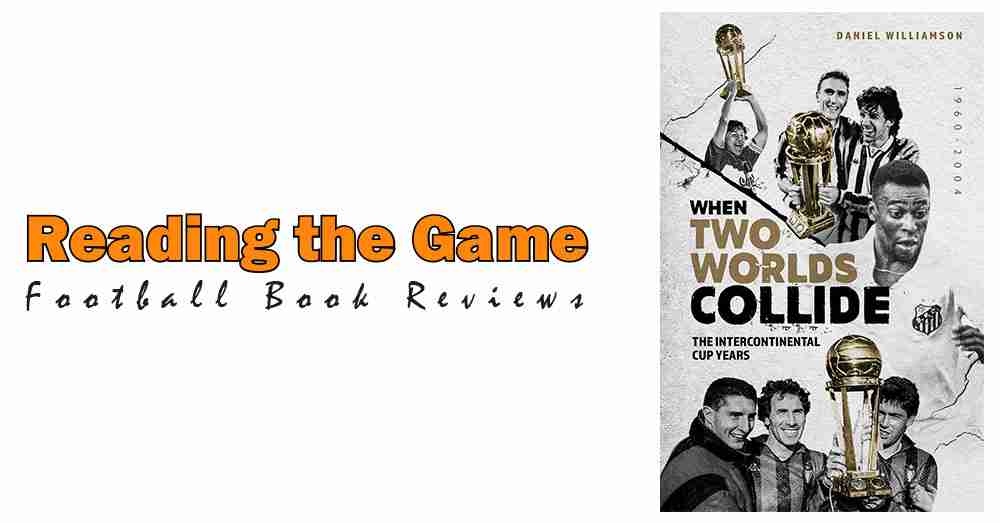For the second consecutive Reading the Game, I find myself reviewing a book that’s only just come out, like a “proper” book blogger. The title in question is When Two Worlds Collide by Daniel Williamson. This history of the defunct and perhaps largely unlamented Intercontinental Cup is Williamson’s second book; his debut, Blue and Gold Passion, was one of the first titles I reviewed.
As much as the Intercontinental Cup was derided by many football fans and, indeed, the clubs due to participate in it – particularly those from Northern Europe – I’ve always been interested in it. This meeting of the continental champions from Europe and South America was inaugurated in 1960 and the idea was to identify the strongest club side in the world at the point the ties were played.
Williamson explores the problems created by the format chosen for the tournament’s first two decades, which went beyond the obvious logistical challenges of playing a two-legged, home and away tie against a club thousands of miles away. The author also doesn’t shy away from the fact that European enthusiasm for the competition declined significantly following the ‘Battle of Montevideo’ in 1967. This spectacularly ill-tempered play-off between Scotland’s Celtic and Racing of Argentina only came about because of the aforementioned peculiar format and scarred the competition more or less permanently.
However, from 1980, the Intercontinental Cup enjoyed a second life, as a one-off match played in Japan and sponsored by Toyota. Williamson’s account of how that came about is really interesting, particularly if (like me) you’ve read a lot about FIFA’s shift from a staid competition organiser to financial behemoth with a dizzying array of tournaments, each with a suite of sponsors.
What makes When Two Worlds Collide such an engaging book is that it goes beyond simply being a collection of match reports and anecdotes. Williamson has sought out and spoken with historians and supporters from many of the clubs to have played in the Intercontinental Cup and placed each edition in its proper context. The acknowledgements list thirty people who spoke directly to the author and are quoted in the text. World Cup winners, legendary coaches and fellow authors all add their knowledge and experience to Williamson’s own research and easy to read prose, shining new light on the competition’s turbulent but rich history .
Cleverly, the narrative also doesn’t follow a strictly chronological order; instead, each chapter is centred around a club, a specific edition of the tournament, an event or an individual. This gives Williamson the flexibility to devote separate chapters to both the Real Madrid whose dominance of European football inspired the Intercontinental Cup and the modern Madrid’s adventures in the later editions of the competition and the FIFA Club World Cup which supplanted it in 2005.
As you might expect from an author whose debut book was about one of the biggest and most successful clubs in Argentina, When Two Worlds Collide isn’t Euro-centric. Instead, it weaves from continent to continent, as the trophy itself did; as is pointed out both within the text and an appendix of statistics, South America actually won 22 of the 43 completed editions of the Intercontinental Cup, to Europe’s 21. The final chapter makes the observation that this competitive balance between the continents has been utterly destroyed by the waves of cash flowing through European football and the coffers of FIFA, whose creation of a larger Club World Cup is as much about generating revenue as it about giving the champion clubs of Africa, Asia, Oceania and CONCACAF a global stage upon which to play.
In some ways, When Two Worlds Collide is a love letter to a bygone era. After all, much of the glamour and prestige of UEFA competitions has been diluted in the last two decades. Given that West Ham United have been parachuted into the play-offs (that is, fourth round) of the Europa Conference League as a reward for finishing seventh in the Premier League and know that, should they progress, they’re committed to a further six matches, there’s an argument that maybe just a teeny bit too much football might be being played. The idea of only one club per country participating in the European Cup and then the eventual winners competing for the right to be considered the best in the world always held a certain allure for me. While those days are gone, they deserve to be remembered; Daniel Williamson has produced a hugely readable, always accessible and massively enjoyable book which will help keep the memory of the Intercontinental Cup alive.
Like so many of the books featured in Reading the Game, When Two Worlds Collide is from Pitch Publishing. You can read a sample of the book and find links to multiple booksellers at the Pitch website. The specialist football bookshop, Stanchion, also has copies available and I can thoroughly recommend getting your hands on one.
